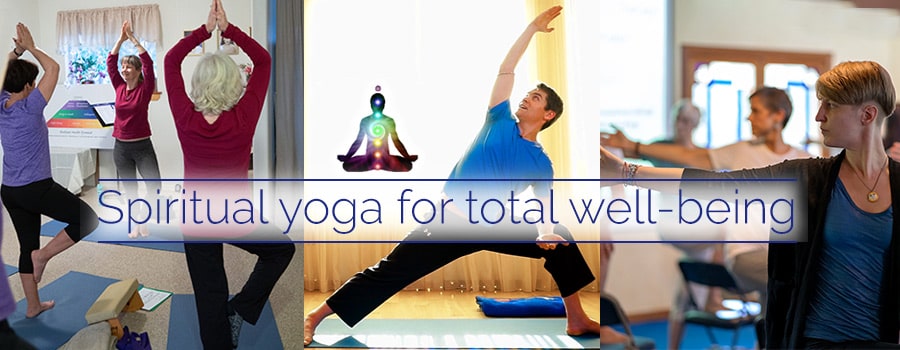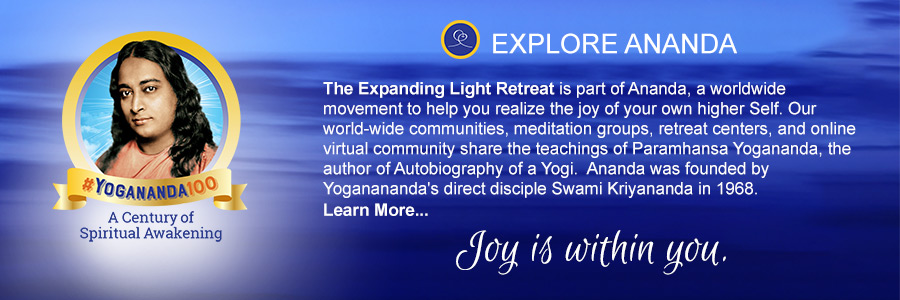Teaching Meditation in Yoga Classes
I had been teaching yoga for 4 years, ever since graduating from Ananda Yoga Teacher Training, Spring 2002. I was running my own yoga business, and instructing 5 – 10 classes a week. Even with that experience under my belt, I felt like (and still do feel like) a teacher-in-training. There is such depth to yoga — always more to learn.
Still, I was getting restless. Was I giving my students enough? I felt stagnant and a little bored, and wondered if my students did too. What more could I give them?
Aha!
Then I began to think, “Wait a minute. I usually meditate after practicing Hatha Yoga because it FEELS SO GOOD then! Wouldn’t it feel good for my students as well?”
Then too, I remembered that, according to Yoga International magazine, Swami Rama (guru of the Himalayan Institute) refused to teach Hatha Yoga unless it included seated meditation. I had enjoyed Meditation Teacher Training at The Expanding Light, so it seems an obvious revelation to me now, but at the time it was an ”AHA!” moment.
Now all my classes (each one is 75 minutes long) end with five minutes of seated meditation. Initially, no one was enthusiastic about meditating at the end of yoga class (except me). Some students groaned, the rest seemed nervous and wary. They didn’t want to mess up their relaxing Savasana, and five minutes seemed like an awfully long time to sit with “nothing to do.” (What has our culture come to?!) But they agreed to try it.
To their amazement, many people enjoyed it right from the start. They discovered how much easier it is to sit tall and relaxed after a physical yoga practice. They like the quiet, the “permission” to be still, and the smooth transition from Savasana to meditation to their “outside” life.
What I Do in My Classes
I don’t give much meditation instruction, just a little each class due to time restrictions, but the effect is cumulative. Sometimes I offer different techniques (Hong-Sau, watching the thoughts rise and fall, watching the breath, etc.). Most students sit cross-legged on the floor, a few sit against a wall, and those with knee issues sit on chairs.
I open with a quote that gets to the heart of meditation from diverse sources such as Yogananda, Alice Walker, Jon Kabat-Zinn, the Tao te Ching, the Torah, Zen Buddhism, and the New Testament. This inclusiveness helps my diverse student population feel accepted and appreciated. (I’ve often wondered if it will get me into hot water with students from fundamentalist traditions, especially since I live in the Deep South, but so far no complaints.)
When I taught at LA Fitness, the students wanted only “a good workout” in their hour class, but I felt antsy afterward. I announced that I would stay after class to meditate, and anyone could join me. (I never asked permission of the club, but I knew the classroom was empty and I wasn’t asking to be paid for the time.)
Sometimes I was the only one who stayed, sometimes a student or two would join me. Very quickly, more people made time to meditate. It was informal — a smidgen of instruction (encouragement to just try, really) — and quite wonderful!
I make an exception to my 5 minute meditation policy for a 50-minute lunchtime class. Because time is so short, I originally dropped meditation, but the class felt incomplete.
Now we start with pranayama (Full Yogic Breath) and end with one minute of seated meditation after Savasana. That teeny bit is better than nothing. As the Bhagavad Gita says, “Even a little practice of meditation will free you from dire fears and colossal sufferings.”
And It Works
I love hearing how students have used meditation and pranayama to cope with difficulties in their lives: surgery, teacher conferences, unemployment, relationships, etc. It tickles me when they say their doctors ask: “How did you stay so calm? You’re the most relaxed patient we’ve seen.”
“It’s from my yoga,” they answer. “You should try it!”
I’ve seen very few yoga teachers follow the asanas with meditation in my area, but I really suggest that you try it. My next plan is to see if LA Fitness will let me offer a half-hour lunchtime meditation program.
Don’t get intimidated by the amount or lack of time, or how much meditation instruction you can offer. As someone once said to me when I was fussing about how to work meditation into my life, “Just sit down and shut up.”
Honestly, once you get over the mental resistance, it’s simple to add meditation to your yoga class — and a little bit of meditation will make a world of difference to your students.
Related Advice
All authors are graduates of Ananda Yoga Teacher Training.





















